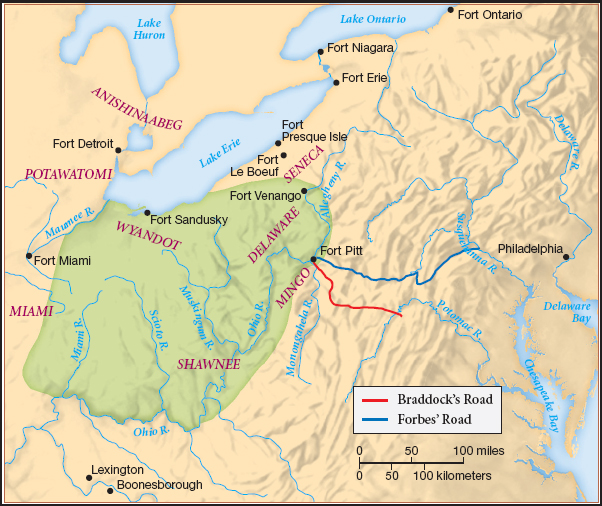America’s History: Printed Page 174
America: A Concise History: Printed Page 155
America’s History: Value Edition: Printed Page 150
Lord Dunmore’s War

In the years since the end of Pontiac’s Rebellion, at least 10,000 people had traveled along Braddock’s and Forbes’s Roads to the headwaters of the Ohio River, where Fort Pitt had replaced Fort Duquesne during the Great War for Empire, and staked claims to land around Pittsburgh (Map 5.5). They relied for protection on Fort Pitt, which remained one of Britain’s most important frontier outposts. But the revenue crisis forced General Gage to cut expenses, and in October 1772, the army pulled down the fort’s log walls and left the site to the local population. Settler relations with the neighboring Ohio Indians were tenuous and ill-defined, and the fort’s abandonment left them exposed and vulnerable.
In the ensuing power vacuum, Pennsylvania and Virginia both claimed the region. Pennsylvania had the better claim on paper. It had organized county governments, established courts, and collected taxes there. But — in keeping with its pacifist Quaker roots — it did not organize a militia. In this decision, Virginia’s royal governor, the Earl of Dunmore, recognized an opportunity. Appointed to his post in 1771, Dunmore was an irascible and unscrupulous man who clashed repeatedly with the House of Burgesses. But when it suited him, he was just as willing to defy the crown. In 1773, he traveled to Pittsburgh, where, he later wrote, “the people flocked about me and beseeched me … to appoint magistrates and officers of militia.” He organized a local militia; soon, men armed by Virginia were drilling near the ruins of Fort Pitt.
In the summer of 1774, Dunmore took the next step. In defiance of both his royal instructions and the House of Burgesses, he called out Virginia’s militia and led a force of 2,400 men against the Ohio Shawnees, who had a long-standing claim to Kentucky as a hunting ground. They fought a single battle, at Point Pleasant; the Shawnees were defeated, and Dunmore and his militia forces claimed Kentucky as their own. A participant justified his actions shortly afterward: “When without a king,” he wrote, “[one] doeth according to the freedom of his own will.” Years of neglect left many colonists in the backcountry feeling abandoned by the crown. Dunmore’s War was their declaration of independence.
PLACE EVENTS IN CONTEXT
Question
What led to Dunmore’s War, and why did western settlers support it?